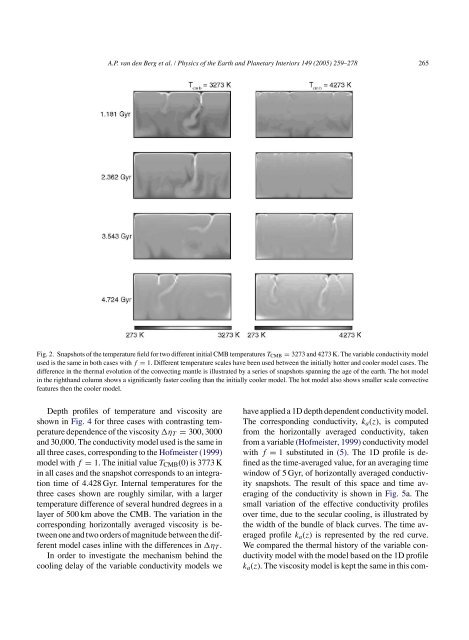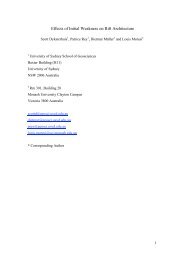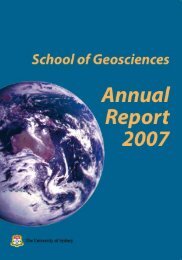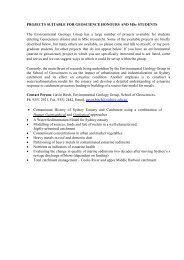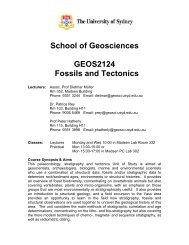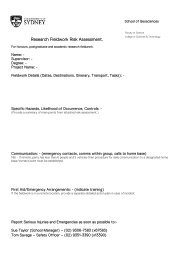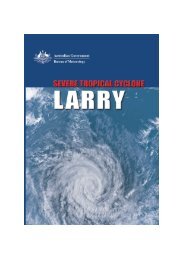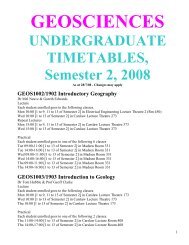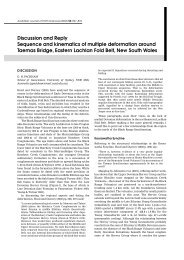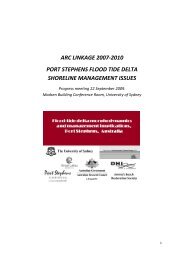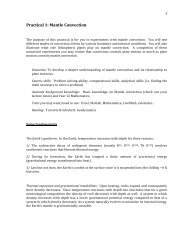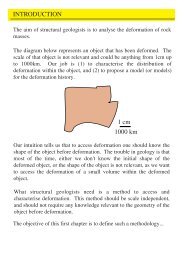van den Berg et al., 2005, Earth Planetary Science Letters.
van den Berg et al., 2005, Earth Planetary Science Letters.
van den Berg et al., 2005, Earth Planetary Science Letters.
You also want an ePaper? Increase the reach of your titles
YUMPU automatically turns print PDFs into web optimized ePapers that Google loves.
A.P. <strong>van</strong> <strong>den</strong> <strong>Berg</strong> <strong>et</strong> <strong>al</strong>. / Physics of the <strong>Earth</strong> and Plan<strong>et</strong>ary Interiors 149 (<strong>2005</strong>) 259–278 265<br />
Fig. 2. Snapshots of the temperature field for two different initi<strong>al</strong> CMB temperatures T CMB = 3273 and 4273 K. The variable conductivity model<br />
used is the same in both cases with f = 1. Different temperature sc<strong>al</strong>es have been used b<strong>et</strong>ween the initi<strong>al</strong>ly hotter and cooler model cases. The<br />
difference in the therm<strong>al</strong> evolution of the convecting mantle is illustrated by a series of snapshots spanning the age of the earth. The hot model<br />
in the righthand column shows a significantly faster cooling than the initi<strong>al</strong>ly cooler model. The hot model <strong>al</strong>so shows sm<strong>al</strong>ler sc<strong>al</strong>e convective<br />
features then the cooler model.<br />
Depth profiles of temperature and viscosity are<br />
shown in Fig. 4 for three cases with contrasting temperature<br />
depen<strong>den</strong>ce of the viscosity η T = 300, 3000<br />
and 30,000. The conductivity model used is the same in<br />
<strong>al</strong>l three cases, corresponding to the Hofmeister (1999)<br />
model with f = 1. The initi<strong>al</strong> v<strong>al</strong>ue T CMB (0) is 3773 K<br />
in <strong>al</strong>l cases and the snapshot corresponds to an integration<br />
time of 4.428 Gyr. Intern<strong>al</strong> temperatures for the<br />
three cases shown are roughly similar, with a larger<br />
temperature difference of sever<strong>al</strong> hundred degrees in a<br />
layer of 500 km above the CMB. The variation in the<br />
corresponding horizont<strong>al</strong>ly averaged viscosity is b<strong>et</strong>ween<br />
one and two orders of magnitude b<strong>et</strong>ween the different<br />
model cases inline with the differences in η T .<br />
In order to investigate the mechanism behind the<br />
cooling delay of the variable conductivity models we<br />
have applied a 1D depth depen<strong>den</strong>t conductivity model.<br />
The corresponding conductivity, k a (z), is computed<br />
from the horizont<strong>al</strong>ly averaged conductivity, taken<br />
from a variable (Hofmeister, 1999) conductivity model<br />
with f = 1 substituted in (5). The 1D profile is defined<br />
as the time-averaged v<strong>al</strong>ue, for an averaging time<br />
window of 5 Gyr, of horizont<strong>al</strong>ly averaged conductivity<br />
snapshots. The result of this space and time averaging<br />
of the conductivity is shown in Fig. 5a. The<br />
sm<strong>al</strong>l variation of the effective conductivity profiles<br />
over time, due to the secular cooling, is illustrated by<br />
the width of the bundle of black curves. The time averaged<br />
profile k a (z) is represented by the red curve.<br />
We compared the therm<strong>al</strong> history of the variable conductivity<br />
model with the model based on the 1D profile<br />
k a (z). The viscosity model is kept the same in this com-


